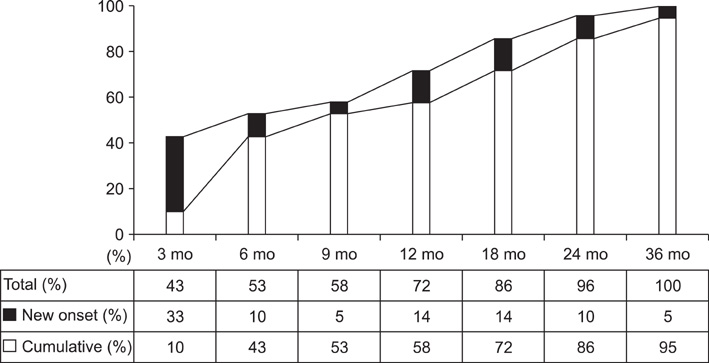J Korean Surg Soc.
2011 Dec;81(6):380-386. 10.4174/jkss.2011.81.6.380.
Is it possible to predict hypothyroidism after thyroid lobectomy through thyrotropin, thyroglobulin, anti-thyroglobulin, and anti-microsomal antibody?
- Affiliations
-
- 1Department of Surgery, Chonnam National University Medical School, Gwangju, Korea. sabiston@hotmail.com
- 2Department of Internal Medicine, Chonnam National University Medical School, Gwangju, Korea.
- KMID: 1445766
- DOI: http://doi.org/10.4174/jkss.2011.81.6.380
Abstract
- PURPOSE
We investigated the incidence and risk factors of hypothyroidism after thyroid lobectomy, and evaluated the possibility to predict hypothyroidism preoperatively with serologic markers, such as thyrotropin (TSH), thyroglobulin (TG), anti-thyroglobulin (ATA), and anti-microsomal antibody (AMA).
METHODS
We enrolled 123 consecutive patients who underwent thyroid lobectomy due to benign conditions between May 2004 and April 2008. Only preoperative euthyroid patients were included. Patients were divided into two groups by postoperative thyroid function outcomes, into hypothyroid (n = 97) and euthyroid groups (n = 26), and analyzed specially for the preoperative levels of TSH, TG, ATA, and AMA.
RESULTS
Twenty-six (21.1%) patients developed hypothyroidism following thyroid lobectomy within 35.7 months of follow-up. The proportion of post-lobectomy hypothyroidism was high in patients with high-normal preoperative TSH level, and the cut-off value was 2.0 mIU/L, with 67% sensitivity and 75% specificity. The quantitative titer of preoperative TG, ATA, and AMA was not significant, but the outcome of categorical analysis of two or more positivities on these three markers was significantly higher in hypothyroid patients than in euthyroid patients (28.6% vs. 3.9%, P = 0.024). The combined positivity of preoperative TSH and two or more positivities of TG, ATA, and AMA possess 100% positive predictive value and 81% negative predictive value.
CONCLUSION
The incidence of hypothyroidism following thyroid lobectomy was 21.1%. High-normal preoperative TSH and two or more positivities for TG, ATA, and AMA are good pre-operative predictive markers. Such high-risk patients need close TSH monitoring before the onset of clinical hypothyroidism.
MeSH Terms
Figure
Reference
-
1. Niepomniszcze H, Garcia A, Faure E, Castellanos A, del Carmen Zalazar M, Bur G, et al. Long-term follow-up of contralateral lobe in patients hemithyroidectomized for solitary follicular adenoma. Clin Endocrinol (Oxf). 2001. 55:509–513.2. Buchanan MA, Lee D. Thyroid auto-antibodies, lymphocytic infiltration and the development of post-operative hypothyroidism following hemithyroidectomy for non-toxic nodular goitre. J R Coll Surg Edinb. 2001. 46:86–90.3. Seiberling KA, Dutra JC, Bajaramovic S. Hypothyroidism following hemithyroidectomy for benign nontoxic thyroid disease. Ear Nose Throat J. 2007. 86:295–299.4. Su SY, Grodski S, Serpell JW. Hypothyroidism following hemithyroidectomy: a retrospective review. Ann Surg. 2009. 250:991–994.5. Tomoda C, Ito Y, Kobayashi K, Miya A, Miyauchi A. Subclinical hypothyroidism following hemithyroidectomy: a simple risk-scoring system using age and preoperative thyrotropin level. ORL J Otorhinolaryngol Relat Spec. 2011. 73:68–71.6. Miller FR, Paulson D, Prihoda TJ, Otto RA. Risk factors for the development of hypothyroidism after hemithyroidectomy. Arch Otolaryngol Head Neck Surg. 2006. 132:36–38.7. Stoll SJ, Pitt SC, Liu J, Schaefer S, Sippel RS, Chen H. Thyroid hormone replacement after thyroid lobectomy. Surgery. 2009. 146:554–558.8. Moon HG, Jung EJ, Park ST, Jung TS, Jeong CY, Ju YT, et al. Thyrotropin level and thyroid volume for prediction of hypothyroidism following hemithyroidectomy in an Asian patient cohort. World J Surg. 2008. 32:2503–2508.9. De Groot LJ, Hall R, McDermott WV, Davis AM. Hashimoto's thyroiditis. A genetically conditioned disease. N Engl J Med. 1962. 267:267–273.10. Arai T, Kurashima C, Utsuyama M, Sawabe M, Ito H. Measurement of anti-thyroglobulin and anti-thyroid peroxidase antibodies using highly sensitive radioimmunoassay: an effective method for detecting asymptomatic focal lymphocytic thyroiditis in the elderly. Endocr J. 2000. 47:575–582.11. Williams ED, Doniach I. The post-mortem incidence of focal thyroiditis. J Pathol Bacteriol. 1962. 83:255–264.12. McHenry CR, Slusarczyk SJ. Hypothyroidisim following hemithyroidectomy: incidence, risk factors, and management. Surgery. 2000. 128:994–998.13. Griffiths NJ, Murley RS, Gulin R, Simpson RD, Woods TF, Burnett D. Thyroid function following partial thyroidectomy. Br J Surg. 1974. 61:626–632.14. De Carlucci D Jr, Tavares MR, Obara MT, Martins LA, Hojaij FC, Cernea CR. Thyroid function after unilateral total lobectomy: risk factors for postoperative hypothyroidism. Arch Otolaryngol Head Neck Surg. 2008. 134:1076–1079.15. Piper HG, Bugis SP, Wilkins GE, Walker BA, Wiseman S, Baliski CR. Detecting and defining hypothyroidism after hemithyroidectomy. Am J Surg. 2005. 189:587–591.16. Woeber KA. Subclinical thyroid dysfunction. Arch Intern Med. 1997. 157:1065–1068.17. Kim HS, Kwon DS, Kim JS, Moon DJ. A clinical analysis of endoscopic thyroid lobectomy and comparison with conventional thyroid lobectomy. J Korean Surg Soc. 2005. 69:450–454.
- Full Text Links
- Actions
-
Cited
- CITED
-
- Close
- Share
- Similar articles
-
- An overview of the pathogenic mechanisms of autoimmune thyroid disorders
- Prospective Observation of 5-Year Clinical Course of Subclinical Hypothyroidism in Korean Population
- A Case of Hashimoto's Thyroiditis Presented with Severe Hypertension and Thyrotoxicosis
- Serum Thyroglobulin Concentrations in Congenital Hypothyroidism
- Natural Course of Juvenile Chronic Lymphocytic Thyroiditis


